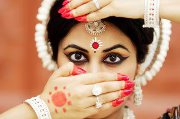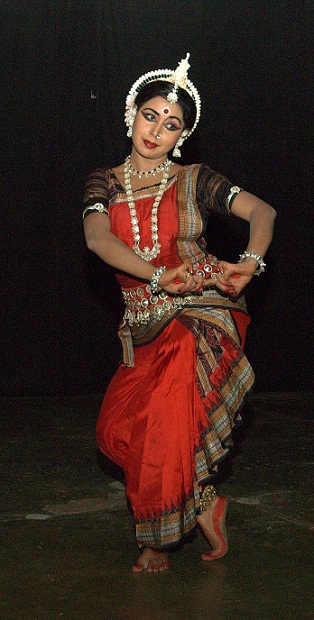Contribute
| Gatha - Traditional, Innovative And Memorable |
Susan Moore
05/23/2013
Dance Performance by
Guru Aruna Mohanty and Orissa Dance Academy
Purely traditional, purely innovative and purely memorable -- this sums up the dance performance given by Guru Aruna Mohanty and her Odissi dance troupe in their stunning portrayal of Indian's cultural heritage through the ancient dance form of Odissi from Orissa. Guru Aruna was trained under the guidance of the late Guru Padmashree Gangadhar Pradhan, founder of the Orissa Dance Academy. Her acclaim as one of India's leading Odissi dancers and choreographers is evident from start to finish of the dance performance.
From the footwork of warriors on the battlefield with their imposing stance of fully drawn bows, to the delicate anointing of fragrances onto Shri Gopala Krishna in an intimate play of Gopis with their beloved lord, no one misses a beat; nothing is lost in the kaleidoscope of bodies moving through time and space on stage as our minds are lead effortlessly in reliving India's greatest epics.
It is sheer joy to see every dancer, as many as ten on stage at once, all dancing in synchrony, their combined footwork quickly, gently or aggressively marking a cadence and creating a single experience for the viewer. Guru Aruna and her dancers, using the most subtle facial expressions, hand gestures and body postures, depict India's greatest themes in such a way that leaves the audience spinning with pure emotion and awe. The backdrop of sung Sanskrit verses punctuates and enlivens the depth of tradition from which they dance.
We begin our journey with an innovative and original dance that offers homage to the timeless Mahabhutas, elements of our shared universe: earth, water, fire, air and space. We see each of these elements come to life with astonishing reality through rhythms, bodily movements and a projected visual backdrop of Nature's wonders. This dance marks Guru Aruna as a refreshing artisan with a keen ability to take a traditional dance form and teach to the modern mind in ways easy for it to comprehend.
We then move into the traditional realm with choreography that uses scenes from the Epic Ramayana to vividly illustrate the theory of Indian Rasas, or flavors; what a westerner might call emotive themes. This piece is brilliant. Guru Aruna uses her dance form to speak of a universal human nature at its depth. Her dancers, true to every mood, impart it with ease and an uncanny ability to draw us in without our even knowing. We see Rama as hero: noble, bold and unwavering; we see the terror coursing through Sita as she is abducted by Ravana; and the compassion of Rama who holds the dying Bird King, Jatayu, in his arms, tenderly giving him his last sip of earthly water; the awe in Rama's eyes as the squat monkeys lumber back and forth with rocks as they devotedly carry out their impossible task to build a bridge to Lanka. And then comes the sheer disgust of a battlefield strewn with dead warriors and foraging vultures, evoking in us the universal repulsion for war. But yet, in the blink of an eye, we make a 180 degree turn and feel relief in Rama's fierce, avenging anger mobilized for battle against the demon King Ravana. And at last, we are brought to feel the rasa of Shanta, peace, as Rama returns victorious after defeating Ravana. This whirlwind of emotion is all seamlessly imparted through the skill of the dancers.
The second half of our journey, again in traditional style, lands us smack dab in the world of Shri Krishna, in the Krishna Saranam dance. We are there and each character is dancing the Lila of the Lord's life on earth. We don't have to imagine nor try to remember the story as it might have been told before. The mime, the faces and the characters draw us in as Krishna lives and plays among the cow herders of Vrindavan. Then we are quickly transported into chaos and injustice as Krishna's life merges with those of the Pandavas struggling to regain their rightful kingdom. Shri Krishna takes charge as commander-in-chief. We feel this as surely as there is light to the day through each and every expression and movement of the dancer portraying Lord Krishna. We are full witness to the Great Bhagavad Gita as it unfolds. We see Arjuna at the battle's onset with his heavy anguish turning to Lord Krishna for guidance. Both parts, Arjuna and Krishna, are danced with raw depth and unerring skill. When Lord Krishna finally captures Arjuna's full awareness, when the moment of full surrender occurs and Arjuna is ready to receive the divine vision, Guru Aruna choreographs this moment magnificently with only a few powerful gestures from Lord Krishna. The impact leaves us transfixed and wondering "how could anyone have created such a moment of reality on stage?"
And as we watch the dance's final conclusion in Lord Krishna's death, once again Guru Aruna uses her skill to visually instruct us in the paradoxical, yet orderly law of Karma. Shri Krishna, even as the great Lord, succumbs to bodily death, predictably reaping a curse's fruit for unjust killing and his role in orchestrating the Mahabharata war, ultimately a war to return Dharma and righteousness to the Earth. In full dignity the dancers surround the dying Krishna with a majestic plumage of peacock feathers, a symbol intimately coupled with the dancing Lord in his Lila of life.
In every detail -- costumes, props, lighting, backdrops -- nothing is used casually; nothing is a visual waste. Everything is done with a professional eye to create mood, depth and dignity: dignity to the dancers, to the audience and to the tradition of Odissi dance.
The final piece is a visual explosion of timeless tribute to Mother India. From the repetition of "Vande Mataram," to the manifold display of images projected onto the backstage, India is depicted as source to an expansive culture, a culture from which this dance form emerges and can rightly return thanks. Guru Aruna and her dancers pay homage with breathtaking energy as they become a unified, yet changing hologram moving against a back drop of shifting Indian scenes.
In all the dance pieces, what was once simply words on a page or pictures in a book becomes a living, breathing reality, as if we are transported back to those ancient times of the Ramayana and Mahabharata. The timelessness that pervades each dance, and each dancer, is nothing short of a miracle. Guru Aruna and her dancers lead us through the emotions of being human, our awareness entrusted in them for a mere two hours which seems like eternity and makes us wish that it were -- that the performance will never end.
And yet, the performance does end; but that isn't the end of our journey. Afterwards, we are privileged to eat and mingle with the Guru and the dancers. The depth of human character displayed on stage overflows onto the crowd as people swarm the dancers and they gracefully absorb compliments, questions and requests for autographs.
It is clear that the inspiration to Aruna's dance is life itself. Her presence can only be summed up as deeply approachable, attentive to each and every person, with a care that comes from a cultured and understanding awareness. And so what was the final vision that we take home from Guru Aruna and her dancers? Life is a dance of our unified humanness. Either observing or acting, we are all intimately connected to one another in our shared humanity and divinity.
For those of us who wish to explore these truths further, we are warmly invited by the Shri Dwarkamai Vidyapeeth of Billerica and Shri Gurusthan of Northboro, the hosts of this event, to visit and be their guests. The two are public service organizations in the area dedicated to promote the teachings of Saint Shri Sai Baba of Shirdi, who lived and served late nineteenth century and early twentieth century. More on the organizations can be noted from http://www.dwarkamai.org and http://www.gurusthan.com. The telephone contacts are 978-27-MYSAI and 774-27-MYSAI.
Orissa Dance Academy is located in Bhubaneswar, Orissa, India, http://www.orissadanceacademy.org For those of us fully enchanted by the Odissi dance form and eager to learn more about it, we are invited to contact any one of the accomplished Odissi dance teachers in greater Boston: Neena Gulati Triveni School of Dance, Brookline, MA. 617-232-5485 gulati.neena@gmail.com www.trivenidance.org ; Jayashree Mohapatra Noopur Dance Academy, Winchester, MA (781) 369-4000 jaya200@yahoo.com; Mouli Pal Upasana Odissi, Wilmington, MA
978-988-3961 mouli_pal@hotmail.com.
You may also access this article through our web-site http://www.lokvani.com/

